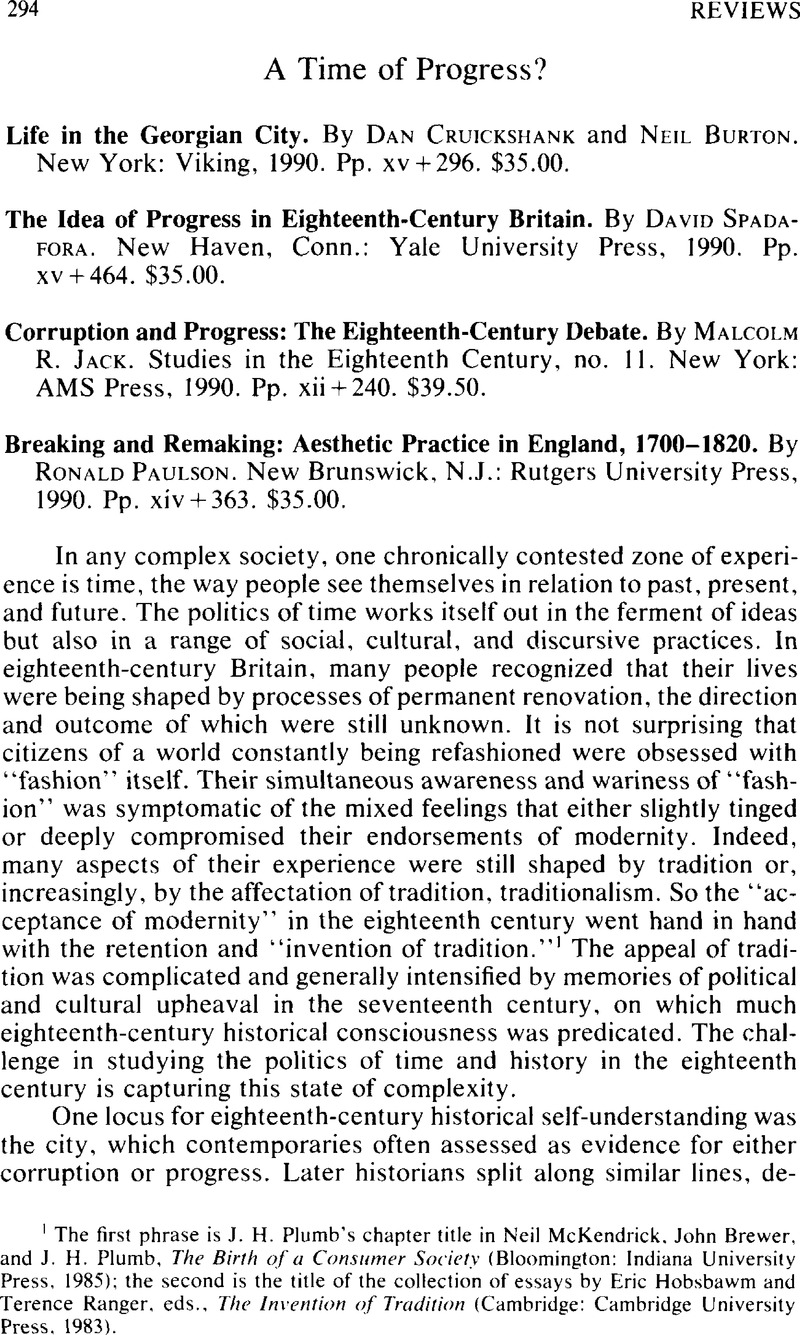No CrossRef data available.
Article contents
A Time of Progress? - Life in the Georgian City. By Dan Cruickshank and Neil Burton. New York: Viking, 1990. Pp. xv + 296. $35.00. - The Idea of Progress in Eighteenth-Century Britain. By David Spadafora. New Haven, Conn.: Yale University Press, 1990. Pp. xv + 464. $35.00. - Corruption and Progress: The Eighteenth-Century Debate. By Malcolm R. Jack. Studies in the Eighteenth Century, no. 11. New York: AMS Press, 1990. Pp. xii + 240. $39.50. - Breaking and Remaking: Aesthetic Practice in England, 1700–1820. By Ronald Paulson. New Brunswick, N.J.: Rutgers University Press, 1990. Pp. xiv + 363. $35.00.
Published online by Cambridge University Press: 10 January 2014
Abstract

- Type
- Reviews
- Information
- Copyright
- Copyright © North American Conference of British Studies 1992
References
1 The first phrase is J. H. Plumb's chapter title in McKendrick, Neil, Brewer, John, and Plumb, J. H., The Birth of a Consumer Society (Bloomington: Indiana University Press, 1985)Google Scholar; the second is the title of the collection of essays by Hobsbawm, Eric and Ranger, Terence, eds., The Invention of Tradition (Cambridge: Cambridge University Press, 1983)Google Scholar.
2 Borsay, Peter, The English Urban Renaissance (Oxford: Oxford University Press, 1989)Google Scholar.
3 Life in the Georgian City is mostly the work of Dan Cruickshank, though Neil Burton wrote chapters on “Servicing the House” and “Town Gardens.”
4 However, a good deal of the material is already available in two other reference volumes by Cruickshank, : A Guide to the Georgian Buildings of Britain and Ireland (London: George Weidenfeld & Nicolson, 1985)Google Scholar, and, especially, London: The Art of Georgian Building (London: Architectural Press, 1975)Google Scholar, written with Peter Wyld.
5 Paulson dominates scholarship on Hogarth, : Hogarth: His Life, Art and Times, 2 vols. (New Haven, Conn., and London: Yale University Press, 1971)Google Scholar—the publication of a revised edition is in progress; Hogarth's Graphic Works, 2 vols. (1965; rev. ed., New Haven, Conn., and London: Yale University Press, 1970)Google Scholar. In addition, he has written many thematic studies of eighteenth-century literature and art, including Emblem and Expression: Meaning in English Art of the Eighteenth Century (Cambridge, Mass.: Harvard University Press, 1975)Google Scholar, Popular and Polite Art in the Age of Hogarth and Fielding (Notre Dame, Ind.: University of Notre Dame Press, 1979)Google Scholar. Book and Painting: Shakespeare, Milton and the Bible—Literary Texts and the Emergence of English Painting (Knoxville: University of Tennessee Press, 1982)Google Scholar. and Representations of Revolution (1789–1820) (New Haven, Conn., and London: Yale University Press, 1983)Google Scholar.
6 Among other things, the book elaborates Paulson's critique of Barrell's, JohnThe Political Theory of Painting from Reynolds to Hazlitt (New Haven, Conn., and London: Yale University Press, 1986)Google Scholar: see Paulson's review of Barrell, (“Shaftesbury Meets Karl Marx”) in the New Republic (August 10 and 17, 1987), pp. 39–42Google Scholar.
7 Monod, Paul, Jacobilism and the English People, 1688–1788 (Cambridge: Cambridge University Press, 1989), p. 348Google Scholar.




